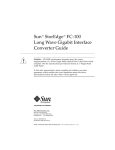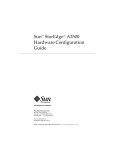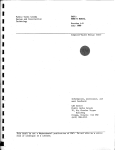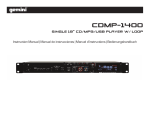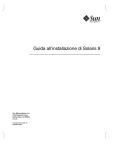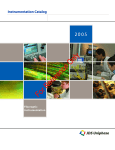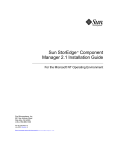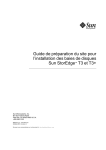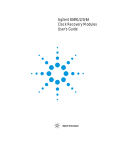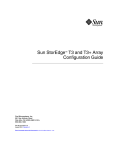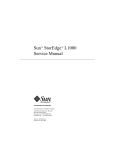Download Long Wave GBIC Service Manual
Transcript
Sun StorEdge™ LW GBIC Service Manual Sun Microsystems, Inc. 901 San Antonio Road Palo Alto, CA 94303-4900 USA 650 960-1300 Fax 650 969-9131 Part No. 806-1528-10 May 1999, Revision A Send comments about this document to: [email protected] Copyright 1999 Sun Microsystems, Inc., 901 San Antonio Road • Palo Alto, CA 94303-4900 USA. All rights reserved. This product or document is protected by copyright and distributed under licenses restricting its use, copying, distribution, and decompilation. No part of this product or document may be reproduced in any form by any means without prior written authorization of Sun and its licensors, if any. Third-party software, including font technology, is copyrighted and licensed from Sun suppliers. Parts of the product may be derived from Berkeley BSD systems, licensed from the University of California. UNIX is a registered trademark in the U.S. and other countries, exclusively licensed through X/Open Company, Ltd. Sun, Sun Microsystems, the Sun logo, StorEdge, AnswerBook2, docs.sun.com, and Solaris are trademarks, registered trademarks, or service marks of Sun Microsystems, Inc. in the U.S. and other countries. All SPARC trademarks are used under license and are trademarks or registered trademarks of SPARC International, Inc. in the U.S. and other countries. Products bearing SPARC trademarks are based upon an architecture developed by Sun Microsystems, Inc. The OPEN LOOK and Sun™ Graphical User Interface was developed by Sun Microsystems, Inc. for its users and licensees. Sun acknowledges the pioneering efforts of Xerox in researching and developing the concept of visual or graphical user interfaces for the computer industry. Sun holds a non-exclusive license from Xerox to the Xerox Graphical User Interface, which license also covers Sun’s licensees who implement OPEN LOOK GUIs and otherwise comply with Sun’s written license agreements. RESTRICTED RIGHTS: Use, duplication, or disclosure by the U.S. Government is subject to restrictions of FAR 52.227-14(g)(2)(6/87) and FAR 52.227-19(6/87), or DFAR 252.227-7015(b)(6/95) and DFAR 227.7202-3(a). DOCUMENTATION IS PROVIDED “AS IS” AND ALL EXPRESS OR IMPLIED CONDITIONS, REPRESENTATIONS AND WARRANTIES, INCLUDING ANY IMPLIED WARRANTY OF MERCHANTABILITY, FITNESS FOR A PARTICULAR PURPOSE OR NONINFRINGEMENT, ARE DISCLAIMED, EXCEPT TO THE EXTENT THAT SUCH DISCLAIMERS ARE HELD TO BE LEGALLY INVALID. Copyright 1999 Sun Microsystems, Inc., 901 San Antonio Road • Palo Alto, CA 94303-4900 Etats-Unis. Tous droits réservés. Ce produit ou document est protégé par un copyright et distribué avec des licences qui en restreignent l’utilisation, la copie, la distribution, et la décompilation. Aucune partie de ce produit ou document ne peut être reproduite sous aucune forme, par quelque moyen que ce soit, sans l’autorisation préalable et écrite de Sun et de ses bailleurs de licence, s’il y en a. Le logiciel détenu par des tiers, et qui comprend la technologie relative aux polices de caractères, est protégé par un copyright et licencié par des fournisseurs de Sun. Des parties de ce produit pourront être dérivées des systèmes Berkeley BSD licenciés par l’Université de Californie. UNIX est une marque déposée aux Etats-Unis et dans d’autres pays et licenciée exclusivement par X/Open Company, Ltd. Sun, Sun Microsystems, le logo Sun, StorEdge, AnswerBook2, docs.sun.com, et Solaris sont des marques de fabrique ou des marques déposées, ou marques de service, de Sun Microsystems, Inc. aux Etats-Unis et dans d’autres pays. Toutes les marques SPARC sont utilisées sous licence et sont des marques de fabrique ou des marques déposées de SPARC International, Inc. aux Etats-Unis et dans d’autres pays. Les produits portant les marques SPARC sont basés sur une architecture développée par Sun Microsystems, Inc. L’interface d’utilisation graphique OPEN LOOK et Sun™ a été développée par Sun Microsystems, Inc. pour ses utilisateurs et licenciés. Sun reconnaît les efforts de pionniers de Xerox pour la recherche et le développement du concept des interfaces d’utilisation visuelle ou graphique pour l’industrie de l’informatique. Sun détient une licence non exclusive de Xerox sur l’interface d’utilisation graphique Xerox, cette licence couvrant également les licenciés de Sun qui mettent en place l’interface d’utilisation graphique OPEN LOOK et qui en outre se conforment aux licences écrites de Sun. CETTE PUBLICATION EST FOURNIE "EN L’ETAT" ET AUCUNE GARANTIE, EXPRESSE OU IMPLICITE, N’EST ACCORDEE, Y COMPRIS DES GARANTIES CONCERNANT LA VALEUR MARCHANDE, L’APTITUDE DE LA PUBLICATION A REPONDRE A UNE UTILISATION PARTICULIERE, OU LE FAIT QU’ELLE NE SOIT PAS CONTREFAISANTE DE PRODUIT DE TIERS. CE DENI DE GARANTIE NE S’APPLIQUERAIT PAS, DANS LA MESURE OU IL SERAIT TENU JURIDIQUEMENT NUL ET NON AVENU. Please Recycle Contents 1. 2. Sun StorEdge™ A5000 LW GBIC Installation Checklist 1-1 1.1 Defining System Hardware Configuration 1.2 Unpacking and Positioning Hardware 1.3 Installing Host-side Components at Local and Remote Sites 1.4 A5x00 Power-On Checks 1.4.1 Table-Top, Single A5x00 Per Host Connection 1.4.2 Rack Configurations Using Hubs 1.4.3 Daisy-Chained Configuration (SW GBICs Only) Checking Cable Loss 1-6 1.6 Configuring the Host 1-6 1.6.1 Not Booting From the A5x00 1.6.2 Booting From the A5x00 1.7 Checking the Configuration 1.8 Testing the Installation 1-2 1-2 1-3 1-4 1-6 1-7 1-8 1-8 Fiber Optic Cable Plant Test Procedures 2.2 1-1 1-2 1.5 2.1 1-1 Required Personnel and Equipment 2.1.1 Required Personnel 2.1.2 Required Equipment 2.1.3 Connector Types 2-1 2-1 2-1 2-1 2-2 Fiber Optic Tester Description 2-4 Contents iii 2.3 Fiber Optic Tester Calibration 2.3.1 2.4 2.5 2.6 3. Fiber Optic Tester Calibration Procedure Test Procedures 2.4.1 Passive Cable Plant Loss Test A.3 Set the Reference Value on Each Fiber Optic Tester 2.4.1.2 Identify the Fiber 2.4.1.3 Testing for Fiber Loss 2.4.2 LW GBIC Launch Power Test 2.4.3 Minimum Power Receive Test Test Procedure Summary 2-10 2-13 2-14 2-15 2-16 2.5.1 Fiber Identification Test 2.5.2 Passive Cable Plant Loss Test 2-16 2.5.3 LW GBIC Launch Power Test 2-17 2.5.4 Minimum Receive Power Test Troubleshooting Information 2-16 2-17 2-17 3-1 A-1 LW GBIC A-2 A.1.1 Laser Safety A.1.2 Optical Characteristics A.1.3 Mechanical Specifications A.1.4 Available Power Budget for Passive Plant A-2 A-3 A-4 Single Mode Cable With Duplex SC Connectors A-4 A-4 A.2.1 Environmental and Safety Specifications A.2.2 Optical Connector and Cable Characteristics Single Mode Cable Plant A.3.1 iv 2-7 2.4.1.1 A. Specifications A.2 2-6 2-7 Maintaining Fiber Optic Cables A.1 2-6 A-6 Single Mode Optical Fiber Specifications Sun StorEdge LW GBIC Service Manual • May 1999 A-4 A-6 A-5 2-8 CHAPTER 1 Sun StorEdge™ A5000 LW GBIC Installation Checklist This chapter gives a detailed procedure for installing Sun StorEdge A5x00 disk arrays and long wave gigabit interface converters (LW GBICs) at sites where host systems are present or also being installed. 1.1 Defining System Hardware Configuration The system configuration must be outlined before beginning any equipment installation. There are only specific configurations which are supported and will function when LW GBICs are used. Before installation of the LW GBICs, the installed cable plant must be certified to meet the EIA/TIA492CAAA cable plant specification. See Section A.3, “Single Mode Cable Plant.” 1.2 Unpacking and Positioning Hardware ● Unpack and position hardware at all sites that have host systems and A5x00 disk arrays. 1-1 1.3 Installing Host-side Components at Local and Remote Sites 1. Install host bus adaptors (HBAs) in the host I/O board(s). 2. Install short and long wave GBICs. a. Install short wave GBIC(s) and connect it/them to associated array(s) or hubs(s). b. Install long wave GBICs, but do not connect them to the single-mode cable plant at this time. Connection of the LW GBICs to the single-mode cable plant will be performed after the cable has been checked for loss. 1.4 A5x00 Power-On Checks 1.4.1 Table-Top, Single A5x00 Per Host Connection 1. Power on the A5x00(s). Wait until the A5x00(s) complete the power-on self-test (POST). 2. Check and/or set enclosure names. To avoid confusion, be sure all enclosures have different names. A temporary name can be assigned now, for example, A, B, C, and so forth; and then these temporary names can be changed to final names after the system boots. It is easier to assign an enclosure name using luxadm than on the FPM. 3. Check the box IDs. If the enclosures are single-connected, that is, if there is only one enclosure per loop, the box ID should be set to zero (0). 4. Verify that all drives are up and spinning. 5. Check the status of all power supplies and fans. 6. Check the loop topology (split or full). There is no split loop configuration support with LW GBICs. 1-2 Sun StorEdge LW GBIC Service Manual • May 1999 7. Check for the correct node count per loop. A node is a drive, an IB, or a host. a. To see the node count, press the “A0 B0 B1 A1” line at the top of the loop view on the FPM. 8. Check the A5x00 IB firmware level using the front panel module or luxadm. Note – IB Firmware 1.09 is required to support the LW GBIC. 9. Note any A5x00 with down-rev firmware for later upgrading. Release 6 of the Software/Firmware Matrix is required for using LW GBICs. 1.4.2 Rack Configurations Using Hubs 1. Power on the A5x00(s). Wait for the A5x00(s) to complete the POST. 2. Check and/or set enclosure names. To avoid confusion, be sure all enclosures have different names. A temporary name can be assigned now, for example, A, B, C, and so forth; and then these temporary names can be changed to final names after the system boots. It is easier to assign an enclosure name using luxadm than on the FPM. 3. Check the box IDs. From top to bottom, the box IDs must be set as follows withing a rack: TABLE 1-1 Enterprise Expansion Cabinet, 1422 mm/56 in. Box ID Location 0 Top 1 2 3 Bottom Chapter 1 Sun StorEdge™ A5000 LW GBIC Installation Checklist 1-3 TABLE 1-2 Sun StorEdge Expansion Cabinet, 1828 mm/72 in. Box ID Location 0 Top 1 2 0 1 2 Bottom 4. Verify that all drives are up and spinning. 5. Check the status of all power supplies and fans. 6. Check the loop topology (split or full). For rack configurations using hubs, all loops must be “full.” 7. Check for the correct node count per loop. A node is a drive, an IB, or a host. a. To see the node count, press the “A0 B0 B1 A1” line at the top of the loopview on the FPM. If the count is incorrect, begin a process-of-elimination troubleshooting sequence. 8. Check the IB firmware level. Note – IB Firmware 1.09 is required to support the LW GBIC. 9. Note any A5x00 with down-rev firmware for later upgrading. Release 6 Revision 1.16 of the Software/Firmware Matrix is required for using LW GBICs. 1.4.3 Daisy-Chained Configuration (SW GBICs Only) ■ Daisy chaining currently is supported with short wave (SW) GBICs only. ■ Daisy chaining with long wave (LW) GBICs is not currently supported. Check to see that your configuration is supported. 1-4 Sun StorEdge LW GBIC Service Manual • May 1999 1. Power on the A5x00 closest to the host. Wait for the A5x00 to complete the POST. 2. Check and/or set enclosure names. To avoid confusion, be sure all enclosures have different names. A temporary name can be assigned now, for example, A, B, C, and so forth; and then these temporary names can be changed to final names after the system boots. It is easier to assign an enclosure name using luxadm than on the FPM. 3. Check the box IDs. From the closest-to-the-host to the furthest-from-the-host, the box IDs are set as follows: TABLE 1-3 Box IDs and Distance to the Host Box ID Location 0 Closest to Host 1 2 3 Furthest from Host 4. Verify that all drives are up and spinning. 5. Check the status of all power supplies and fans. 6. Check the loop topology (split or full). For daisy-chain configurations using hubs, all loops must be “full.” 7. Check for the correct node count per loop. A node is a drive, an IB, or a host. a. To see the node count, press the “A0 B0 B1 A1” line at the top of the loopview on the FPM. If the count is incorrect, begin a process-of-elimination troubleshooting sequence. 8. One at a time, power on the next A5x00 in the chain and repeat steps 2 through 7 of these procedure. Verify that the node count increases appropriately as each A5x00 is added to the chain. Chapter 1 Sun StorEdge™ A5000 LW GBIC Installation Checklist 1-5 1.5 Checking Cable Loss To ensure that the customer’s installed cable plant meets or exceeds the cable loss specification for use with LW GBICs, use the following procedure. This procedure enables you to quickly check the customer’s 9/125 micron single mode cable plant for optical loss characteristics. ● Use the passive cable loss procedure and measure each fiber in the cable plant for loss. See Section 2.4.1, “Passive Cable Plant Loss Test.” The cable loss for any one fiber must not be greater than 8.2 dB. If any fiber fails the cable loss test, the customer must contact his/her cable plant supplier and have the set of fibers re-tested. 1.6 Configuring the Host 1.6.1 Not Booting From the A5x00 1. Install the Solaris™ operating environment, if needed. 2. Halt the system and connect all the A5x00 cables. Boot the system with boot -r . 3. After the system boots, use luxadm to display and verify that all A5x00s are present. 4. Set the enclosure names to facilitate configuration. 5. Install all appropriate software patches, including IB firmware, HBA fcode, and disk drive firmware, if needed. Be sure to consult all patch READMEs before beginning patch installations. 6. Reboot the system. 1-6 Sun StorEdge LW GBIC Service Manual • May 1999 1.6.2 Booting From the A5x00 1. Verify that the IBs, HBAs, and disk drives are at the latest firmware level before installing Solaris. If it is necessary to upgrade the firmware level of any of these, it is much easier to do when the boot disk is not an A5x00. 2. Connect only the boot A5x00 to the system. 3. Install Solaris, if needed. Select the “No Reboot” option of suninstall. After Solaris is completely installed, use luxadm set_boot_dev to set the boot device to an A5x00 disk. 4. Halt the system and connect all remaining A5x00 cables, if appropriate. Boot the system with boot -r . 5. After the system boots, use luxadm to display and verify that all A5x00s are present. 6. Set the enclosure names to facilitate configuration. 7. Install all appropriate patches, including the IB firmware, HBA fcode, and disk drive firmware, if needed. Be sure to consult all patch READMEs before beinning patch installations. 8. If you have to upgrade the IB firmware, HBA fcode, or disk drive firmware to the boot device path components, you must shut down the system. Firmware downloads cannot be done with I/Os going to the target device. Use the following procedure to perform such upgrades: a. Copy the appropriate file(s) to some other location not on the boot path. If such a device is not available, boot off the CD-ROM. This temporarily mounts the boot disk and copies the file(s) to /tmp . b. Halt the system and boot in single-user mode from the CD-ROM or the network. c. Mount the disk used to store the file(s) and peform the appropriate upgrade commands. d. Reboot the system. Chapter 1 Sun StorEdge™ A5000 LW GBIC Installation Checklist 1-7 1.7 Checking the Configuration 1. Re-check that all A5x00s are present using luxadm probe and luxadm display. 2. Verify that all ses devices in the /dev/es directory are linked properly, taking into account multiple paths. 3. Verify that all disk drive device links in /dev/dsk and /dev/rdsk are present, taking into account multiple paths. 1.8 Testing the Installation ● Run the StorTools 3.0 installation verification for at least 6 hours to verify the installation. 1-8 Sun StorEdge LW GBIC Service Manual • May 1999 CHAPTER 2 Fiber Optic Cable Plant Test Procedures 2.1 Required Personnel and Equipment 2.1.1 Required Personnel Two qualified system support engineers are required. They must be trained in the use of the EXFO FOT-30A fiber optic tester. These engineers must read and understand the test procedures presented herein. 2.1.2 Required Equipment See TABLE 2-1 for the required equipment for each test. 2-1 TABLE 2-1 2.1.3 Required Fiber Optic Cable Plant Test Equipment Quantity Description 2 EXFO FOT-30A (Part No. FOT-32A-02BL-54) 2 FOT power supplies 2 1-meter (SC to SC) 9-micron test cable (single fiber) 2 Photo detector SC converter (black plastic device included with FOT) 4 Female-to-female SC connectors 2 SC to SC—Single Mode fiber cable 2 Telephone located near fiber termination points at both sites 1 FC-AL 7 port hub Connector Types Note – The customer’s cable plant may be terminated with connectors other than SC connectors. This section shows some of the possible connector types that you may see. The customer must supply the correct fiber cabling to connect the cable plant to the LW GBIC. FIGURE 2-1 2-2 SC Connectors Sun StorEdge LW GBIC Service Manual • May 1999 FIGURE 2-2 ST Connectors—Bayonet FIGURE 2-3 FC Connectors—Threaded FIGURE 2-4 SC Adapters—SC Female-to-Female Chapter 2 Fiber Optic Cable Plant Test Procedures 2-3 2.2 Fiber Optic Tester Description Photo detector SC connector 1310 nm laser source SC connector SOURCE METER nm 1310 AC 9V dBm 2kHz auto off low bat FIBER-OPTIC TESTER FOT-30A SOURCE on/off CW 2kHz SOURCE POWERMETER λ select dBm W EXFO FIBER-Optical Engineering FIGURE 2-5 2-4 CW EXFO Fiber Optic Tester Sun StorEdge LW GBIC Service Manual • May 1999 ref Power meter wavelength in nm Incoming 2-kHz signal Reference value in dBm Source wavelength SOURCE AC Operation AC 9 volt battery operation 9V Low Battery Indicator low bat 1310 METER 1310 nm Signal emitted by the source CW dBm 2kHz auto off Auto shut off Power reading in dBm or µW Referenced reading in dB FIGURE 2-6 EXFO Fiber Optic Tester Display Description Toggles source between 2-kHz or continuous wave operation SOURCE Powers the FOT on or off on/off CW 2kHz SOURCE Toggles source on or off POWERMETER Selects the power meter wavelength λ select dBm W Accesses referenced (dB) mode ref Accesses absolute mode (dBm or µW) FIGURE 2-7 EXFO Fiber Optic Tester Keypad Description Chapter 2 Fiber Optic Cable Plant Test Procedures 2-5 2.3 Fiber Optic Tester Calibration Both fiber optic testers must be calibrated before any of the test procedures are performed. Note – The calibration procedure must be performed each time the fiber optic tester is used. 2.3.1 Fiber Optic Tester Calibration Procedure Use the following procedure to calibrate both fiber optic testers. 1. Be sure that the thumbscrew cap is on the photodetector. This is the large black cap on the fiber optic tester. 2. Turn on the fiber optic tester using the on/off button. 3. Press and hold the λ select button until the CAL message appears on the display. This will take about 10 seconds. After calibration, the unit will display a dashed line indicating a reading below range. The fiber optic tester is now calibrated. FIGURE 2-8 shows the fiber optic tester after calibration. SOURCE AC 9V METER 1310 2-6 CW dBm 2kHz low bat FIGURE 2-8 nm auto off Fiber Optic Tester After Calibration Sun StorEdge LW GBIC Service Manual • May 1999 Note – Err 1 indicates that the thumbscrew is not fitted properly. Press any key to remove the error message, then secure the thumbscrew cap on the detector and repeat the calibration procedure. 2.4 Test Procedures 2.4.1 Passive Cable Plant Loss Test This test measures the passive cable plant loss of each fiber in the cable plant. The test ensures that the cable loss budget is not exceeded due to: ■ ■ ■ ■ bad cable splices incomplete fiber connections exceeded fiber bend radius dirty connectors This procedure requires that both fiber optic testers be references to each other at a single site and then be moved to the cable plant termination points. See FIGURE 2-9. The reference value is obtained from the laser source that will be used for measurement. Cable Plant db 0.00 EXFO db 0.00 EXFO EXFO Reference testers at a single location FIGURE 2-9 EXFO Move to fiber end points Fiber Optic Testers Referenced to Each Other Chapter 2 Fiber Optic Cable Plant Test Procedures 2-7 TABLE 2-2 2.4.1.1 Procedure Overview Task Description 1. Calibrate both fiber optic testers according to section 2.3.1. 2. Set the reference value for each fiber optic tester. 3. Move the fiber optic testers to the end points of the cable plant. 4. Identify the correct fibers in the cable plant. 5. Test for passive cable plant loss. Set the Reference Value on Each Fiber Optic Tester Note – Before taking attenuation measurements, you must reference the power meters to a laser source. The attenuation test shows how much light was lost as it travels through a fiber from a light source. Set the reference on both fiber optic testers with the source from the companion fiber optic tester by doing the following. 1. Connect the light source on each of the fiber optic testers with the photo detector on the companion fiber optic tester. Use a 1-meter single mode fiber cable to connect both fiber optic testers to each other as shown in FIGURE 2-10. SOURCE AC 9V low bat FIGURE 2-10 2-8 METER nm 1310 SOURCE CW dBm 2kHz auto off AC METER 9V low bat Setting the Reference Value on Both Fiber Optic Testers Sun StorEdge LW GBIC Service Manual • May 1999 nm 1310 CW dBm 2kHz auto off 2. After both fiber optic testers are connected, turn on both laser sources by selecting the source button. “1310” is indicated in the upper left portion of the liquid crystal display of both testers, and a vertical marker will appear next to the “CW” marker. This indicates that the source is turned on and sending a continuous wave signal from the laser source. See FIGURE 2-11 for the tester display after the laser source has been turned on. SOURCE AC 1310 9V METER nm 1310 CW dBm 2kHz auto off low bat FIGURE 2-11 Fiber Optic Tester With 1310 nm Continuous Wave Laser Source Turned On 3. Be sure that the fiber optic tester is in the absolute mode (power meter wavelength, in nm, must be displayed in the upper right portion of the display). If not, use the “dBm/W” key to set it to this mode. SOURCE AC 1310 9V low bat FIGURE 2-12 Fiber optic tester in absolute mode METER nm 1310 CW dBm 2kHz auto off Fiber Optic Tester in the Absolute Mode 4. Set the operating wavelength of each fiber optic tester to 1310 nm to match the source wavelength, using the λ select key. 5. Press the “ref” key on each fiber optic tester to set each tester to the referenced mode. A reference value (in dBm) will appear in the upper right portion of the display. Chapter 2 Fiber Optic Cable Plant Test Procedures 2-9 AC SOURCE METER 1310 -6.75dBm 9V low bat dB 0.00 FIGURE 2-13 CW 2kHz auto off Fiber Optic Tester With Reference Value Set 6. Press and hold the “ref” button until the display shows 0.00 db loss and a new reference value appears in the upper right portion of the display. 7. The fiber optic tester is now “zeroed out.” This is the reference value that will be used to test for overall fiber loss. 2.4.1.2 Identify the Fiber It is possible to get a power reading that seems correct, but is conncted to the wrong set of fibers. This is because the fiber optic tester will be receiving light from a source that is originating from a GBIC and not the light source on the fiber optic tester. Because it is easy to make a cabling mistake when there are a large number of fibers installed in the cable plant, use the following cable identification procedure. Identify the fiber by sending a 2 kHz signal out from the laser source on one of the fiber optic testers and check for the 2 kHz signal on the other fiber optic tester. If the 2 kHz signal is detected, a two-second beep will indicate that the fiber is connected, and that the correct fiber has been identified. FIGURE 2-14 shows how the testers are connected for this purpose. 2-10 Sun StorEdge LW GBIC Service Manual • May 1999 Cable Plant 2000 2000 EXFO FIGURE 2-14 EXFO Testers Connected to Identify the Fiber The following steps require that the two fiber optic testers be moved to the termination points of the installed cable plant. 1. Install the black plastic SC socket connector on the photodetector of each fiber optic tester. 2. Establish telephone contact with each site and confirm which cable will be connected to the source and the photodetector at each end of the cable plant. 3. Connect each fiber optic tester to the fiber plant using the yellow 15-meter singlemode fiber that ships with the LW GBIC. 4. Connect both the source and photodetector of both fiber optic testers to the termination point of the cable plant on the fibers that you want to test for fiber loss. The source on one tester must connect to the fiber that is connected to the photodetector on the companion tester. See FIGURE 2-14. 5. On each fiber optic tester, press and hold the source button until a bar appears on the right side of the tester indicating “CW” (continuous wave). This indicates that the source is turned on. See FIGURE 2-15. Chapter 2 Fiber Optic Cable Plant Test Procedures 2-11 AC SOURCE METER 1310 -6.75dBm 9V low bat dB 0.00 FIGURE 2-15 CW 2kHz Continuous Wave selected auto off 1310 nm Laser Source Turned On 6. On each fiber optic tester, select 2 kHz by pressing the “CW/2kHz” button to toggle between 2 kHz and CW (continuous wave). The setting will be displayed on the right side of the fiber optic tester display. 2 kHz selected AC SOURCE METER 1310 -6.75dBm 9V low bat dB 0.00 FIGURE 2-16 CW 2kHz auto off 1310 nm Laser Source Turned On and 2 kHz Signal Active 7. If the receiving unit detects a 2 kHz tone, both fiber optic testers will beep for 2 seconds and display “2000 Hz” in the upper right corner of the display. This indicates that you have a working set of fibers with which to perform a fiber loss measurement. See FIGURE 2-17. 2-12 Sun StorEdge LW GBIC Service Manual • May 1999 SOURCE AC 1310 METER 2000 Hz 9V low bat dB 0.00 FIGURE 2-17 CW 2kHz auto off Tone Detection Display 8. If you do not have the correct fiber selected, go back to step 4. Locate the correct set of fibers and repeat steps 4 through 8. 2.4.1.3 Testing for Fiber Loss After you have located the correct set of fibers, you are ready to test each fiber strand for passive fiber loss. 1. Press the “ref” button on the fiber optic tester and a reading will appear. If the reading is equal to or greater than 8.2 db, then the fiber is “O.K.” AC SOURCE METER 1310 -6.75dBm 9V low bat FIGURE 2-18 dB 4.2 CW 2kHz auto off Cable Loss Measurement Display on Fiber Optic Tester 2. Switch the source and photodetector at both ends of the cable plant and check the fiber loss in the reverse direction. The fiber loss readings should be within 0.5 db of each other. Chapter 2 Fiber Optic Cable Plant Test Procedures 2-13 3. If any of the tests in steps 1 and 2 are failed: a. Re-seat all connectors that are in the path that you are testing and re-test for loss. b. Clean the fiber connection and re-test for loss. c. Check that no part of the cable has exceeded the bend radius. d. Call in the cable plant provider and have the provider re-test the cable plant. 2.4.2 LW GBIC Launch Power Test 7.5 dBm EXFO FIGURE 2-19 LW GBIC Launch Power Test The LW GBIC launch power test measures the absolute launch power of the laser source in the LW GBIC. FIGURE 2-19 shows the cabling diagram for the LW GBIC launch power test. In this test you will measure the source strength of the laser in the LW GBIC. The IBM LW GBIC specification defines laser launch power to between -9 dBm and -3 dBm at 1310 nm. If the laser source power is below or above this specification, the LW GBIC must be replaced. Note – The IBM LW GBIC specification defines laser launch power to be between -9 dBm and -3 dBm at 1310 nm. 2-14 Sun StorEdge LW GBIC Service Manual • May 1999 Launch power can only be determined when a GBIC is measured from a FC-AL hub port. Do not try to measure launch power from an Interface Board (IB) on an A5x00 or the host bus adapter (HBA) on the I/O board. You will find that the laser source is cycling off and on every few seconds. Because of this it is not possible to get an accurate power reading on the fiber optic tester. 1. Insert an LW GBIC into an open port on an FC-AL hub. Be sure that there is power applied to the hub. Connect the 1-meter single mode cable between the lower port on the GBIC (this is the laser source) and the photodetector on the fiber optic tester. 2. Turn on power to the fiber optic tester and push the λ select key until the upper right corner displays “1310 nm”. 3. Push the “dBm/W” button until the middle right side displays “dBm”. 4. Use the fiber optic tester to take a power launch reading. The reading must be between -9 dBm and -3 dBm. Note – LW GBIC launch power must be between -9 dBm and -3 dBm. 5. Replace the LW GBIC if it is not within this range. 2.4.3 Minimum Power Receive Test Cable Plant dBm 11.5 EXFO FIGURE 2-20 Measuring Minimum Receive Power Chapter 2 Fiber Optic Cable Plant Test Procedures 2-15 This test is similar to the GBIC launch power test, but measures the absolute receive power at the far end of the cable plant using the laser source from the LW GBIC. Power measurements are taken after the laser source from the GBIC has traveled through the cable plant. Minimum receive power must be greater than -17.7 dBm. FIGURE 2-17 shows the cabling for the minimum receive power test. 1. Insert an LW GBIC into an open port on an FC-AL hub at the remote location. Be sure that there is power applied to the hub. At the local end, connect the 15-meter single mode cable between the cable plant termination point and the photodetector on the fiber optic tester. Note – To ensure that you have selected the correct cable, follow the procedure in Section 2.4.1.2, “Identify the Fiber” on page 2-10. 2. Turn on power to the fiber optic tester and push the λ select key until the upper right corner displays “1310 nm”. 3. Push the “dBm/W” button until the middle right side displays “dBm”. 4. Use the fiber optic tester to take a power launch reading. The reading must be greater than -17.7 dBm. 5. If the reading is below -17.7 dBm, re-seat all connectors in the fiber path and re-test. If the reading is still below -17.7 dBm, replace the LW GBIC and re-test. 2.5 Test Procedure Summary 2.5.1 Fiber Identification Test ■ ■ 2.5.2 Passive Cable Plant Loss Test ■ 2-16 Send a 2 kHz signal between two fiber optic testers. Listen for a 2-second tone and “2000 Hz” to be displayed on the LCD. The cable loss budget must not exceed 8.2 db. Sun StorEdge LW GBIC Service Manual • May 1999 2.5.3 LW GBIC Launch Power Test ■ 2.5.4 Minimum Receive Power Test ■ 2.6 LW GBIC launch power must be between -9.0 dBm and -3.0 dBm. The absolute minimum receive power must be greater than -17.7 dBm. Troubleshooting Information ■ The same methods using STORtools to troubleshoot the A5x00 also apply when the LW GBIC is used to connect the A5x00. Chapter 2 Fiber Optic Cable Plant Test Procedures 2-17 2-18 Sun StorEdge LW GBIC Service Manual • May 1999 CHAPTER 3 Maintaining Fiber Optic Cables Caution – Follow these guidelines to avoid causing damage to fiber optic cables. ■ The minimum bend radius for fiber optic cable is 3 centimeters (1.2 inches). ■ Be sure to grasp the connector when disconnecting a fiber optic cable. Never disconnect a fiber optic cable by pulling on the cable. ■ To avoid damage due to contamination or abrasion, always put dust covers on the fiber optic cable connectors when the cable is disconnected. ■ Dirty fiber optic cable connectors can impede data transfer. ■ Before replacing a fiber optic cable, be sure that the connectors on the cable and LW GBIC are clean. 1. Disconnect the fiber optic cable. 2. Lightly dip a cotton swab in a solution of pharmaceutical-grade isopropyl alcohol. Note – The cotton swab must be of optical grade. It is not provided by Sun. 3. Use the swab and clean the inside of both connectors, as well as the insides of the LW GBICs and other connectors. 4. Reconnect the connectors. If the fiber optic cable still registers as being faulty, replace the fiber optic cable. 3-1 3-2 Sun StorEdge LW GBIC Service Manual • May 1999 APPENDIX A Specifications This appendix contains specifications for the following components: ■ LW GBIC—page A-2 ■ Single Mode Cable With Duplex SC Connectors—page A-4 ■ Single Mode Cable Plant—page A-6 A-1 A.1 LW GBIC This section contains specifications for the LW GBIC. The LW GBIC meets or exceeds the Fiber Channel Standard 100-SM-LC-L specification. A.1.1 Laser Safety The LW GBIC is Class I Laser safe under single fault conditions for the when used with Sun-approved power sources at the operating temperatures specified in Section A.1.2 “Optical Characteristics” on page A-3. TABLE A-1 Laser Safety Standards Parameter References International Standards IEC825-1 and IEC 825-2 FDA Standard CDRH 21 CFR Ch1. Sub J Part 1040.10 Class 1 Laser Product Luokan 1 Laserlaite Klasse 1 Laser Apparat Laser Klasse 1 FIGURE A-1 A-2 Laser Compliance Label Sun StorEdge LW GBIC Service Manual • May 1999 A.1.2 Optical Characteristics TABLE A-2 Link Parameter Min Max Nominal bit rate (B) 1062.5±200 PPM Mb/s Operating range (L) 2m Loss budget 10.5 dB1 Typical fiber core diameter (MFD) 8.5 10 Km 9.8 1. Available power for power cable plant = 8.2 dB at 10 km. TABLE A-3 Transmitter Parameter Min Max Spectral center frequency (l) 1285 nm RMS 1345 nm RMS Spectral width (∆l) Launched power (P) 2.5 nm RMS -9.5 dBm -3 dBm Relative intensity noise (RIN) Extinction ratio (Ex) -120 dB/Hz 9 dB OE deterministic jitter (DJ) 0.20 UI1 (pk-pk) OE total jitter (TJ) 0.43 UI (pk-pk) Optical rise and fall time2 320 ps 1. 1 UI=941 pico-seconds 2. The optical rise and fall time is 20%-80% unfiltered. If a 4th order Bessel Thompson filter is used, the unfiltered rise and fall time would be: TRise/Fall = √ ((Trise/fall measured)2 - (Trise/fall filter)2) TABLE A-4 Receiver Parameter Min Max Received power -20 dBm -3 dBm Operating wavelength 1270 nm 1355 nm Receiver power for Ber 1E-12 -17.7 dBm Return loss of receiver (RL) 12 dB OE deterministic jitter added (DJ) 0.17 UI (pk-pk) added by the converter only. OE total jitter added (TJ) 0.15 Ui (pk-pk) added by the converter only. Appendix A Specifications A-3 A.1.3 Mechanical Specifications TABLE 3-1 Mechanical Specifications Parameter Specification Optical Connector Insertion 250 times1 LW GBIC Insertion 100 times2 1. The number of times SC Duplex connector can be inserted/removed into the LW GBIC. 2. The number of times a LW GBIC unit can be inserted/removed in to the mating assembly. A.1.4 Available Power Budget for Passive Plant The fiber channel allowed loss budget at 10 km is 2.7 dB. A.2 Single Mode Cable With Duplex SC Connectors Cable assemblies comply with the EIA/TIA 492CAAA specification. The single mode cable color is yellow, and the LW GBIC casing is blue. These colors implement fiber channel adapted color coding. A.2.1 Environmental and Safety Specifications TABLE A-5 Environmental and Safety Specifications Parameter Min Max Storage temperature (at 5% to 95% RH) -40˚ C 80˚ C Operating temperature (at 10% to 90% RH) -10˚ C 70˚ C Flame retardance (OFNR)1 1666 Cable material minimum rating (UL-94) V-1 1. UL specification for cable flame retardation. A-4 Sun StorEdge LW GBIC Service Manual • May 1999 A.2.2 Optical Connector and Cable Characteristics TABLE A-6 Optical and Mechanical Characteristics of the Connector Parameter Min 1 Mean optical connector loss Optical connector loss + 3 0.25 dB 1 0.5 dB Connector optical return loss (RL)2 Fiber tensile proof test Cable bend radius -30 dB 100 Kpsi 3 30 mm Ferrule end radius 10 mm Connector apex offset 25 mm 50 mm 4 Connector axial retention 90 N Insertion/withdrawal force Off axial rotational pull Max 4 80 N 20 N Cable/connector pull strength 90 N Mating durability/insertion 500 1. Verified with OFSTP-7 method. 2. Verified with FOTP-107 method. 3. Excess loss is less than 0.5 dB if the fiber is wrapped around a 30-mm radius Mandrel once. 4. Maximum optical loss variation is less than 0.5 dB. Appendix A Specifications A-5 A.3 Single Mode Cable Plant All cable plants must meet or exceed the requirements of EIA/TIA 492CAAA and use approved single mode optical fibers such as Corning SMF-28 or Lucent equivalent. A.3.1 Single Mode Optical Fiber Specifications TABLE A-7 Single Mode Optical Fiber Specifications Parameter Min Max Mode field diameter (MFD) 8.8 µm 9.3 µm (core diameter) Cladding diameter 124 µm 126 µm Cladding non-circularity 1% Cable cutoff wavelength Fiber attenuation at 1310 nm 1260 nm 1 0.4 dB/Km 1 0.05 dB/Km Excess attenuation Zero dispersion wavelength (λ0) 1301.5 dB/Km Zero dispersion slope (S0) 1. For temperature range of -10˚ C to 85˚ C and 4% to 98% RH. A-6 Sun StorEdge LW GBIC Service Manual • May 1999 1321.5 dB/Km 0.092 ps/(nm2•Km)






































